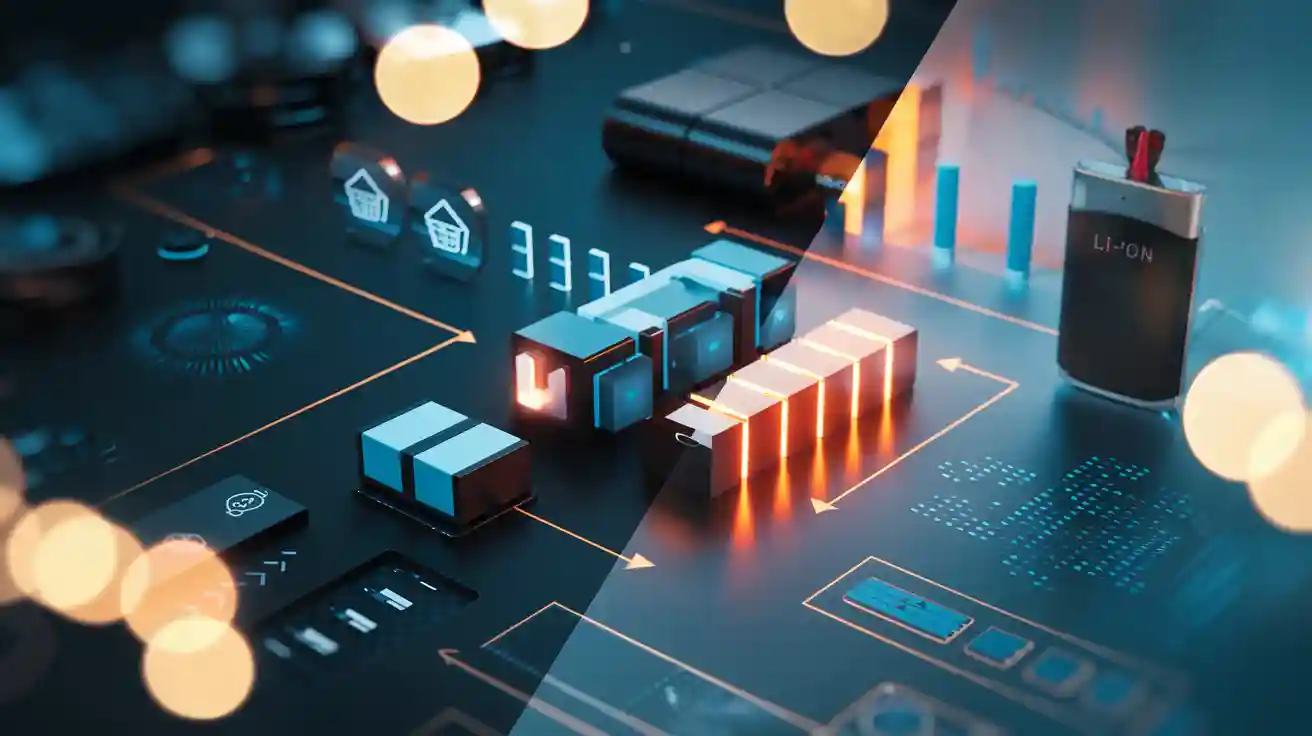
You might wonder if a li-ion battery pouch beats prismatic or cylindrical cells for energy storage in 2025. The answer depends on what you need from your battery. Each lithium format—pouch, prismatic, or cylindrical—offers unique strengths for energy, safety, and design. Check out how the lithium battery market shapes up:
| Battery Form Factor | Market Share (2025) | Growth | Key Uses |
|---|---|---|---|
| Prismático | ~48% | Stable | Cars, buses, trucks |
| Cilíndrico | ~31% | Steady | Bikes, hybrids |
| Pouch | Fastest growth | 22.5% CAGR | Niche, high energy storage systems |
As you read, think about energy, cycle life, and safety. You’ll find tips for picking the right lithium battery for your storage needs.
Li-Ion Battery Pouch Basics
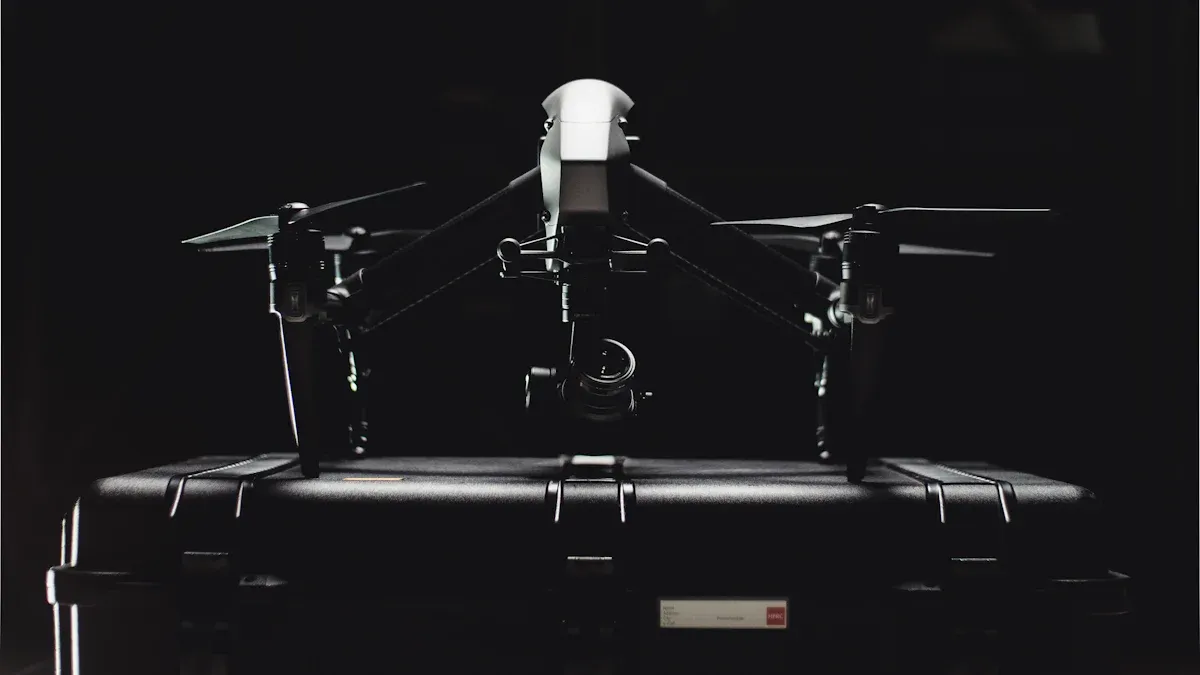
What Is a Li-Ion Battery Pouch
You might see a li-ion battery pouch in many modern devices. This type of battery uses a flexible, flat pouch instead of a hard metal case. Inside, you find layers that work together to store and release energy. Here’s what makes up a typical lithium battery pouch:
- Cathode: This is the positive side, often made from lithium cobalt oxide, lithium manganese oxide, or lifepo4. It stores lithium ions when you charge the battery.
- Anode: The negative side, usually made from graphite, lets lithium ions move out during use.
- Electrolyte: This liquid helps lithium ions travel between the cathode and anode.
- Separator: A thin layer keeps the two sides apart, stopping short circuits but letting ions pass.
- Pouch casing: A soft, laminated foil made from aluminum and plastic protects the battery and keeps it light.
Manufacturers stack these layers, fill them with electrolyte, and seal them inside the pouch. This design gives you a battery that is thin, light, and easy to shape.
Key Features and Benefits
Lithium battery pouches stand out for many reasons. You get more energy in less space because the pouch skips heavy metal parts. The flexible pouch cell design lets you fit batteries into tight or odd-shaped spaces. Here are some top benefits:
- Alta densidad energética—more power in a smaller package.
- Flexible shapes and sizes for custom applications.
- Lighter weight compared to other lithium battery types.
- The pouch can swell safely if there’s a problem, instead of bursting.
- Fast, cost-effective manufacturing.
- Fewer parts mean fewer things can go wrong, so you get better reliability.
- High packaging efficiency—up to 95% of the pouch is usable battery.
If you need a battery that fits a unique space or needs to be light, a lithium battery pouch is a smart choice.
Tip: Lifepo4 pouch cell batteries offer even better safety and longer life, making them popular for demanding uses.
Aplicaciones típicas
You’ll find lithium battery pouches in all sorts of places. Their light weight and flexible design make them perfect for many applications. Here’s a quick look at where you might see them:
| Industry | Applications / Use Cases |
|---|---|
| Electrónica de consumo | Smartphones, tablets, wearables |
| Electric Vehicles (EVs) | Battery packs for cars, buses, and bikes |
| Productos sanitarios | Portable monitors, oxygen concentrators |
| Drones and RC Devices | Lightweight power for flight |
| Renewable Energy | Solar and wind energy storage |
Lifepo4 pouch cell batteries shine in electric vehicles and energy storage. You also see them in power tools and medical equipment. The applications of lifepo4 pouch cells keep growing as technology advances. If you need a battery for a slim phone, a powerful car, or a solar backup, lithium battery pouches can fit your needs.
Alternatives to Lithium Battery Pouches
Células prismáticas
You might see prismatic cells in many energy storage systems and electric vehicles. These lithium batteries use a hard, rectangular metal case. This design gives them strong protection and helps them handle shocks and bumps. Prismatic cells work well in places where you need a tough battery that fits into a set space.
Here’s a quick look at how prismatic cells compare to pouch cells:
| Characteristic | Prismatic Lithium Cells | Pouch Lithium Cells |
|---|---|---|
| Diseño | Rigid metal casing, rectangular shape | Flexible, thin, pouch-like design |
| Structural Strength | High durability, better resistance to shocks and vibration | Less durable due to flexible packaging |
| Peso | Heavier due to metal casing | Lightweight due to absence of rigid casing |
| Design Flexibility | Limited, fixed rectangular shape | High flexibility, adaptable to custom shapes |
| Production Efficiency | Easier mass production with uniform shape | Simpler manufacturing process but less standardized |
| Conductividad térmica | Better heat dissipation due to metal casing | Lower thermal conductivity |
| Volumetric Energy Density | Moderado | Generally higher, maximizing capacity in compact spaces |
| Cost Considerations | Potentially more cost-effective at very high volumes | Often more cost-effective due to simpler manufacturing |
| Aplicaciones típicas | Energy storage systems, automotive, power tools | Wearables, drones, medical devices, custom battery designs |
You will often find lifepo4 prismatic cell batteries in home energy storage, electric cars, and backup power systems. These batteries last a long time and stay safe, even when used every day.
Células cilíndricas
Cylindrical cells look like small tubes. You see them in power tools, e-bikes, and even some cars. These lithium batteries use a steel shell, which makes them strong and easy to stack together. The shape helps them cool down faster, which is great for high-power applications.
- Cylindrical batteries use a winding process, so they have stable quality and lower cost.
- They are heavier than pouch cells, but they handle bumps and drops better.
- Pouch cells are lighter and can fit into more shapes, but they need extra protection.
- Cylindrical cells have higher internal resistance, which means they lose a bit more energy as heat.
- Lifepo4 prismatic cell batteries offer better safety and longer life than many cylindrical types.
You might pick cylindrical lithium batteries if you want something tough and easy to replace. They work well in devices that need lots of small batteries packed together.
Other Formats
Lithium batteries come in many types, each with special features. Some of the most popular are lifepo4 prismatic cell, lithium cobalt oxide, and lithium nickel manganese cobalt oxide. Each type fits different applications.
| Lithium Battery Type | Características principales | Beneficios | Inconvenientes | Typical Uses |
|---|---|---|---|---|
| Fosfato de litio y hierro (LFP) | Uses phosphate cathode, long life cycle (>2,000 cycles) | Durable, safe, thermally stable, can be discharged 100% without damage | Lower specific energy, reduced performance in cold temperatures | Lead-acid replacement, home energy storage |
| Óxido de litio y cobalto (LCO) | High specific energy, low specific power | High energy for low-load applications | Short lifespan, expensive cobalt, low thermal stability | Smartphones, laptops, portable electronics |
| Óxido de litio, níquel, manganeso y cobalto (NMC) | Balanced energy and power density, relatively safe | Good energy and power density | Baja cycle life than LFP, uses cobalt and nickel | EVs, energy storage |
| Óxido de litio, níquel, cobalto y aluminio (NCA) | High energy density, similar to NMC | Alta densidad energética | Prone to thermal runaway, cobalt and nickel dependency | EVs (e.g., Tesla) |
| Óxido de litio y manganeso (LMO) | High specific power, fast charging | Fast charging, good thermal stability | Short cycle life (500-800 cycles) | Power tools, medical devices, some EVs |
| Lithium Titanate Oxide (LTO) | Very high cycle life (up to 10,000), fast charging | Long life, less polluting | Low energy density, expensive due to more cells needed | Specialized applications |
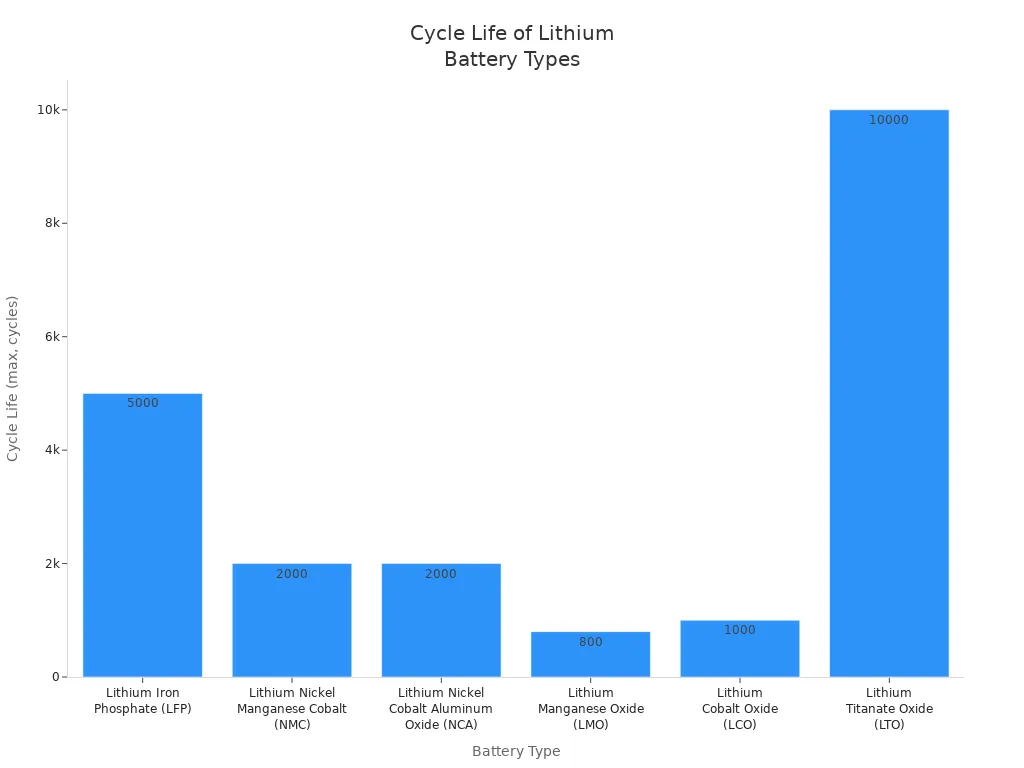
You can see that lifepo4 prismatic cell batteries stand out for safety and long life. If you want a battery for home energy storage or solar backup, this type works very well. Other lithium batteries, like NMC or LCO, fit best in portable electronics or electric vehicles. Always match the battery type to your applications for the best results.
Battery Comparison
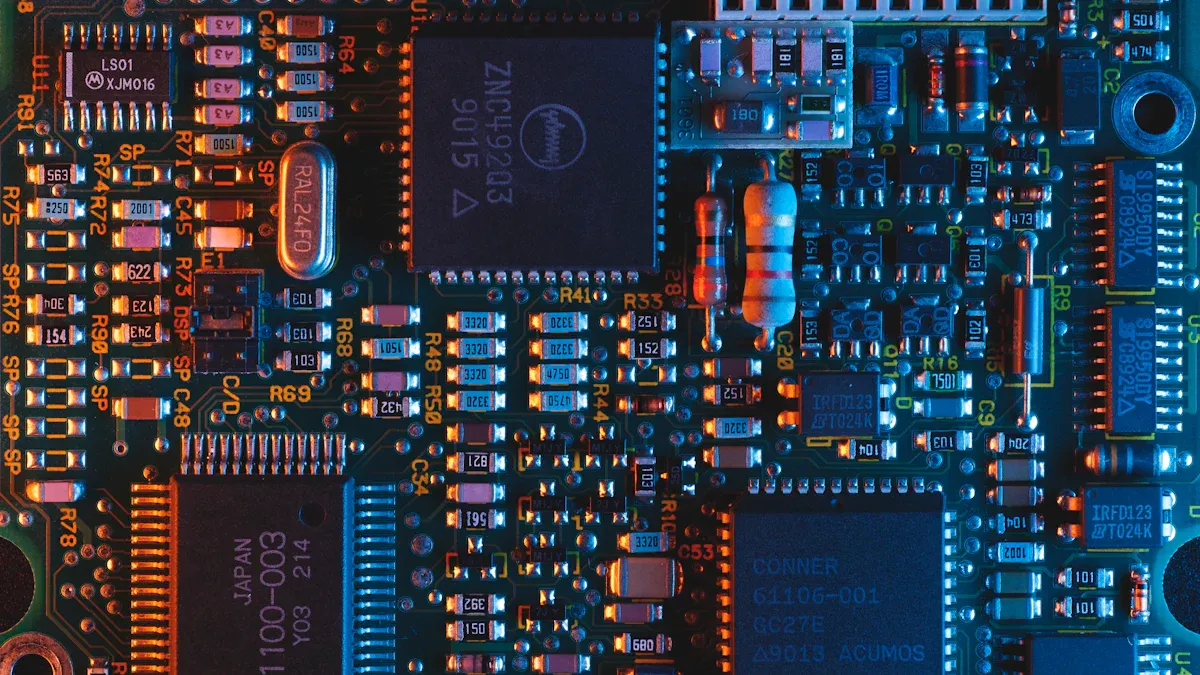
Densidad energética
When you look at lithium battery pouches, prismatic cells, and cylindrical cells, energy density stands out as a key factor. Energy density tells you how much energy a battery can store for its size or weight. If you want high energy density, you often turn to pouch cells. These batteries use thin layers and flexible packaging, so you get more energy in less space. Pouch cells usually reach 90 to 160 Wh/kg, which means they pack a lot of power into a small area.
Prismatic cells come close to pouch cells in energy density, especially when you use lifepo4 chemistry. Their rectangular shape lets you stack them tightly, so you waste less space. Cylindrical cells, on the other hand, have lower packing efficiency because of their round shape. This means you lose some space between each cell, so the overall energy density drops.
| Característica | LiFePO4 Pouch Cell | LiFePO4 Prismatic Cell |
|---|---|---|
| Densidad energética | Typically 90 to 160 Wh/kg | Approaching pouch cell levels |
| Design Type | Flexible, lightweight | Rigid, heavier |
| Space Efficiency | High (thin stacking) | Slightly lower (bulkier) |
| Mechanical Strength | Moderate (handle carefully) | Very high (robust) |
| Ciclo de vida | 3,000–6,000 cycles | 3,000–5,000 cycles |
In real-world uses like electric vehicles or solar storage, you need to balance energy density, cost, and safety. If you want the highest energy density and a lightweight battery, lithium battery pouches are a great pick. Prismatic cells give you almost the same density with more strength. Cylindrical cells work well when you need lots of small batteries together, but they do not match the high energy density of pouch or prismatic cells.
Note: High energy density helps you fit more power into smaller devices, but always check if your application needs that much density or if other factors matter more.
Seguridad
Safety matters a lot when you choose a lithium battery. All three types—pouch, prismatic, and cylindrical—face risks like embalamiento térmico. This happens when a battery gets too hot, which can lead to fires or explosions. You need to know how each format handles these risks.
- The most common safety risks include:
- Thermal runaway from overheating or damage
- Physical damage like cracks or punctures
- Overcharging or deep discharging
- High discharge rates
- Manufacturing defects
Cylindrical cells offer the best safety features. Their metal casing protects the battery and helps it cool down. Prismatic cells also have a strong shell, but they do not cool as well as cylindrical cells. Lithium battery pouches have the highest safety risk. Their flexible packaging can get damaged more easily, and they do not get rid of heat as well. If you want enhanced safety, you should handle pouch cells with care and use them in stable environments.
| Cell Type | Características de seguridad | Safety Risk Level |
|---|---|---|
| Cilíndrico | Robust metal casing, efficient heat dissipation | Considered the safest form factor |
| Prismático | Rigid structure, some cooling, less effective than cylindrical | Moderate safety risk |
| Pouch | Flexible, vulnerable to damage, dense packing can cause hot spots | Highest safety risk |
Tip: Lifepo4 pouch cell batteries offer enhanced safety and longer cycle life, making them a smart choice for demanding uses.
Coste
Cost efficiency is another big factor when you pick a lithium battery. In 2025, the price per kilowatt-hour for these batteries keeps dropping, but you still see differences between formats. Cylindrical cells usually cost the least because factories can make them quickly and in large numbers. Prismatic cells cost a bit more, especially with lifepo4 chemistry, because of their design and materials. Lithium battery pouches fall in the middle, with prices ranging from $90 to $130 per kWh, depending on order size and chemistry.
| Cell Format | Cost per kWh (2025) | Additional Information |
|---|---|---|
| Células de la bolsa | $90 – $130 | Bulk pricing, varies with order volume |
| Células prismáticas | ~91 | LFP chemistry, slightly higher cost |
| Células cilíndricas | ~$87 | Streamlined production, cost advantage |
| Average Li-ion Cells | ~$85 | At pack level, BloombergNEF estimate |
If you want the best cost efficiency, cylindrical cells often win. Prismatic and pouch cells offer better performance in some areas, but you might pay a little more for those benefits.
Durabilidad
Durability tells you how long a battery will last and how well it handles daily use. This is where cycle life comes in. Cycle life means how many times you can charge and discharge a battery before it loses too much capacity.
Prismatic cells have the longest cycle life. They support deep discharges and keep their power for thousands of cycles. Cylindrical cells have a moderate cycle life, usually between 1,500 and 4,000 cycles, depending on how you use them. Lithium battery pouches have the shortest cycle life. They can swell or rupture if you push them too hard, and they do not handle deep cycling as well.
| Cell Type | Average Cycle Life (cycles) | Notas adicionales |
|---|---|---|
| Cilíndrico | 1,500 (EV use) to 3,000-4,000 (other uses) | Moderate cycle life; cell balancing issues |
| Prismático | Longest cycle life | Supports deep discharge; more expensive |
| Pouch | Shortest cycle life | Susceptible to swelling and rupture |
If you want a battery that lasts a long time, prismatic cells with lifepo4 chemistry are your best bet. They give you a long lifespan and steady performance.
Design Flexibility
Design flexibility can make or break your project. Lithium battery pouches shine here. You can shape them to fit almost any space, thanks to their flexible aluminum-plastic film. This lets you create new battery models for unique devices. Pouch cells are lighter and hold more power for their size compared to prismatic or cylindrical cells.
- Pouch batteries let you:
- Customize shapes for your needs
- Save weight in your design
- Maximize capacity in tight spaces
- Use them in stable, compact environments
Prismatic cells come in fixed rectangular shapes, so you get less flexibility. Cylindrical cells are even more limited because of their round, rigid shells. If you need a battery for a slim device or a custom fit, lithium battery pouches are the way to go.
Note: Design flexibility helps you build lighter, more efficient products with high energy density and enhanced safety.
Application Suitability
You want the right battery for your job. Each format fits different needs. Lithium battery pouches work best in devices where you need high energy density, light weight, and a custom shape. You see them in smartphones, drones, and medical devices. Prismatic cells, especially lifepo4, are perfect for home energy storage, electric vehicles, and backup systems. They offer long cycle life, enhanced safety, and high power.
Cylindrical cells are great for power tools, e-bikes, and devices that need lots of small batteries packed together. They give you good cost efficiency and solid performance, but not the highest energy density.
For high-capacity or high-discharge applications in 2025, lifepo4 batteries stand out. They handle high temperatures, deliver strong power, and last for thousands of cycles. Larger cylindrical cells like 21700 or 4680 offer more capacity, but lifepo4 chemistry gives you the best balance of power, cycle life, and enhanced safety.
Tip: Always match your battery to your application. Think about energy density, power, safety, efficiency, and cycle life before you choose.
Li-Ion Battery Pouch Performance
Capacity and Discharge Rate
When you look at lithium battery pouches, you notice they pack a lot of power into a small space. These batteries often deliver higher capacity than other lithium types of the same size. You can find pouches in smartphones, power tools, and even electric vehicles. If you need a battery that gives strong power bursts, pouches can handle high discharge rates. This means you get quick energy for things like drones or backup systems. The higher capacity of these batteries helps your devices run longer between charges. You can rely on them for steady power, even when you use your device all day.
Internal Resistance
Internal resistance is a big deal for battery performance. Lower resistance means your battery delivers power more efficiently. Lithium battery pouches usually have internal resistance between 10 and 80 milliohms (mΩ). As the battery ages, this number goes up. When resistance rises, you see voltage drops, less capacity, and more heat. This can shorten the battery’s lifespan and make your device shut down sooner. Here’s a quick look at how resistance compares:
| Tipo de batería | Typical Internal Resistance (mΩ) | Performance Impact Summary |
|---|---|---|
| Lithium-ion pouch cells | Approximately 10-80 | Resistance increases with age, causing voltage sag, less capacity, heat, and efficiency loss. |
| 18650 Lithium-ion | 20-80 | Voltage stability drops under load; higher resistance can cause early shutdowns. |
| LiFePO4 (26650) | 2-20 | Lower resistance gives better cycle life and efficiency, especially in EVs. |
Tip: Keep your battery cool and avoid deep discharges to help maintain low resistance.
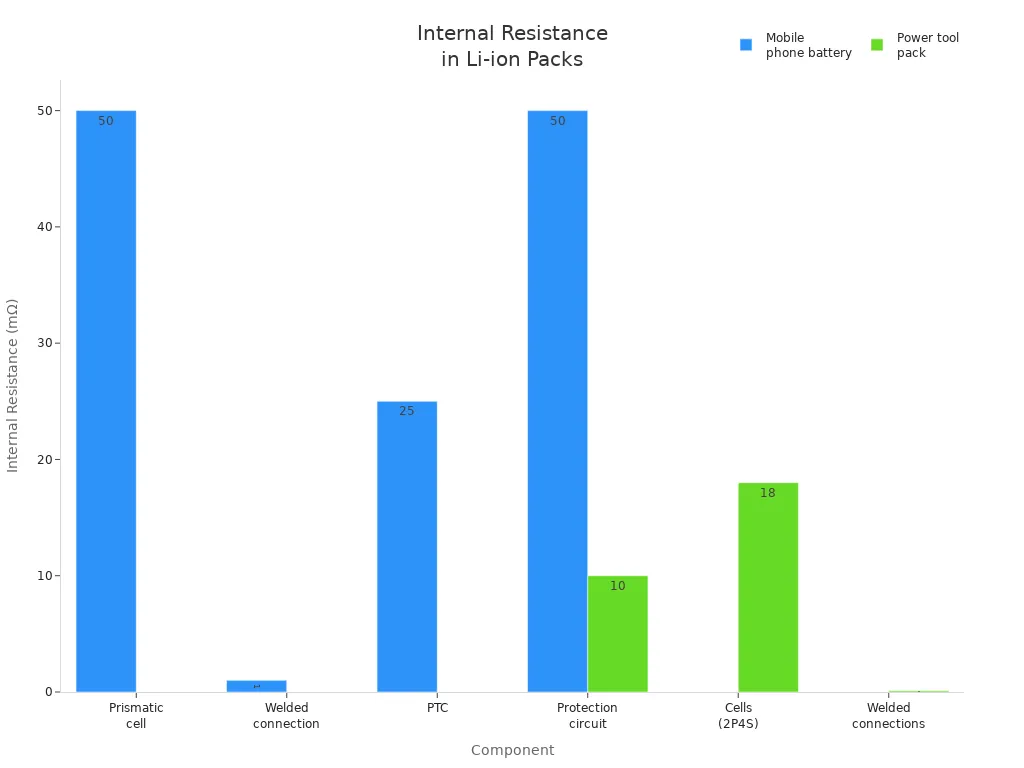
Ciclo de vida
Cycle life tells you how many times you can charge and use your battery before it loses too much power. Lithium battery pouches with LFP chemistry last longer than those with NMC. LFP batteries can handle regular charging to 100% without much wear. NMC batteries give you more energy in a smaller pouch, but they need careful charging and cooling. If you want a battery that lasts for years, LFP pouches are a smart pick. You get thousands of cycles, which means less worry about replacing your battery soon.
- LFP pouches: Longer cycle life, safe to charge fully, stable for many years.
- NMC pouches: Higher energy, but shorter cycle life and need more care.
How Long Does a Lithium Battery Pouch Last
You might ask, how long does a lithium battery pouch last? The answer depends on how you use it and the chemistry inside. For energy storage, LiFePO4 lithium battery pouches often last over 6,000 cycles. That’s about 15 to 20 years if you use one cycle each day. Quality pouches in storage systems usually last 10 a 15 años, with up to 10,000 cycles before losing much capacity. If you wonder how long does a lithium battery pouch last in other devices, it can be shorter—maybe 2 to 10 years—depending on use and care.
| Tipo de batería | Typical Lifespan (years) |
|---|---|
| Iones de litio (Li-ion) | 2 – 10 |
| Lithium Iron Phosphate (LiFePO4) | 5 – 15 |
| Lithium Polymer (LiPo) | 2 – 5 |
| Lithium Manganese Oxide (LiMn2O4) | 3 – 7 |
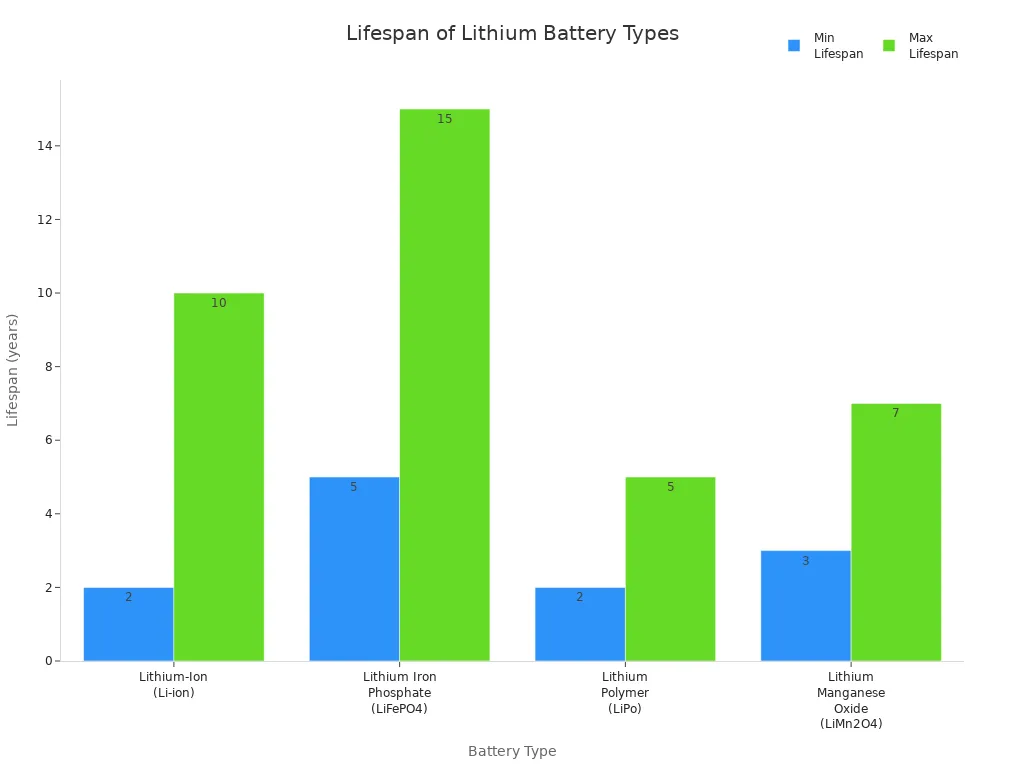
Note: If you want to get the most out of your lithium battery pouches, keep them cool, avoid deep discharges, and use the right charger. This helps answer the question, how long does a lithium battery pouch last, with the best possible result.
Choosing the Right Lithium Battery Pouches
Assessing Your Needs
Before you pick a lithium battery pouch, you need to know what you want from your storage system. Start by asking yourself a few simple questions:
- What will you use the battery for? (Home storage, backup power, portable devices, or electric vehicles)
- How much energy do you need to store?
- How much space do you have for the battery?
- Do you need the battery to deliver power quickly, or just for long, steady use?
- What is your budget?
You should also think about the chemistry inside the battery. Lifepo4 pouch cells are a top choice for many storage projects. They give you great efficiency, long cycle life, and strong safety. If you want a battery that lasts for years and keeps your home or business running, lifepo4 is hard to beat.
He aquí algunas key factors to consider when you assess your needs:
- Battery chemistry and form factor (like lifepo4 pouch cells)
- Safety and performance features
- Cost versus quality
- Certifications (such as UL 9540 or UL 9540A)
- Specific requirements for your application
You want a battery that fits your space, meets your power needs, and keeps you safe. If you plan for these things now, you will save time and money later.
Tip: Always check the cycle life and efficiency of the battery. Lifepo4 pouch cells often last longer and work better for storage than other types.
Matching Battery to Application
Now that you know your needs, you can match the right battery pouch to your application. Every project is different, so you want to make sure your battery fits your goals.
- Choose the right voltage and configuration. If you need more voltage, connect cells in series. For more capacity, connect them in parallel.
- Pick the best chemistry. Lifepo4 pouch cells are great for storage because they offer high efficiency, thermal stability, and long life.
- Check the discharge rate. Some applications, like power tools or drones, need batteries that can deliver energy fast. Others, like home storage, need steady power over time.
- Think about the environment. Will your battery face hot or cold temperatures? Lifepo4 pouch cells handle heat better than many other types.
- Make sure your battery has safety features. Look for overcharge, over-discharge, and short-circuit protection. Certifications like UL1642 and IEC62133 show the battery meets strict safety standards.
- Fit the battery to your space. Measure your device or storage area to make sure the pouch will fit.
- Work with trusted suppliers. Good support and quality control matter for long-term projects.
Here’s a quick checklist to help you match your battery to your application:
| Paso | What to Check |
|---|---|
| Tensión | Series or parallel setup for your needs |
| Química | Lifepo4 for storage, NMC for high energy |
| Discharge Rate | High for tools, steady for storage |
| Temperatura | Lifepo4 pouch cells for hot/cold environments |
| Seguridad | Certifications and built-in protections |
| Talla | Measure your space before buying |
| Supplier | Choose reputable brands |
Note: Use a Sistema de gestión de baterías (BMS) to keep your pouch cells balanced and safe. This helps extend the life and efficiency of your storage system.
Practical Tips
You want your battery pouch to last and work well. Here are some practical tips to help you get the most out of your storage setup:
-
Measure Twice, Buy Once
Always measure your available space before you order a battery pouch. Lifepo4 pouch cells come in many sizes, so you can find one that fits just right. -
Choose the Right Chemistry
Lifepo4 pouch cells are perfect for storage. They offer high efficiency, long cycle life, and strong safety. If you need more energy in a smaller space, you might look at NMC, but lifepo4 is usually better for most storage applications. -
Check Certifications
Look for batteries with UL, IEC, or UN DOT 38.3 certifications. These show the battery meets strict safety and quality standards. -
Mind the Environment
Store your battery pouch in a cool, dry place. Lifepo4 pouch cells work well in many temperatures, but extreme heat or cold can lower efficiency and shorten life. -
Use the Right Charger
Make sure your charger matches the voltage and current of your battery pouch. This keeps your battery healthy and efficient. -
Install a BMS
A Battery Management System helps balance your pouch cells, protects against overcharging, and keeps your storage system running smoothly. -
Plan for the Future
Think about how your needs might change. Lifepo4 pouch cells can last for thousands of cycles, so choose a size and setup that can grow with you.
🚩 Quick Tip: If you want carga rápida, make sure your battery and charger are compatible. Lifepo4 pouch cells support quick charging, but only if you use the right equipment.
By following these steps, you can build a storage system that is safe, efficient, and ready for anything. Lifepo4 pouch cells give you the best mix of efficiency, safety, and long life for most storage applications.
Trends for 2025
Home Energy Storage
You will see big changes in home energy storage in 2025. More people want to keep their homes powered during blackouts or save money on their electric bills. Lithium-ion batteries now hold about two-thirds of the energy storage market. Many new homes with solar panels also add battery storage. In fact, almost 78% of new solar homes in developed countries use batteries.
Why is this happening? Battery prices keep dropping because electric vehicle production is growing. Lifepo4 batteries are leading the way. They last a long time—over 8,000 cycles—and stay safe. Companies like Tesla and BYD now use lifepo4 in their home energy storage systems. You will also notice new designs. Batteries are smaller, modular, and look better in your home. Smart systems use AI to help you save energy and even sell extra power back to the grid.
- The home energy storage market is set to double by 2025, reaching over 60 GWh.
- Lifepo4 pouch batteries are now the top choice for safety and long life.
- Government programs and new safety rules make it easier and safer to add storage to your home.
Commercial and Industrial Use
Businesses and factories also want better energy storage systems. They need to keep machines running and avoid high energy costs. Lifepo4 batteries are popular here too. They handle lots of charging and last for years. Many companies use large lifepo4 battery banks to store energy from solar panels or the grid. This helps them stay open during power cuts and save money.
You will see more smart controls in these systems. AI helps manage when to charge or use stored energy. Companies can even join virtual power plants, sharing stored energy with the grid for extra income. Lifepo4 batteries make these systems safer and more reliable.
Portable Devices
You use portable devices every day—phones, tablets, and wearables. In 2025, lithium battery pouches with lifepo4 chemistry will power more of these gadgets. These batteries are light and can fit into thin or odd-shaped spaces. They also pack a lot of energy, so your devices last longer between charges.
- Pouch cells can reach high energy density, sometimes over 700 Wh/kg.
- The flexible design lets makers build slimmer, lighter devices.
- Lifepo4 pouch batteries add safety and longer life to your favorite electronics.
You will notice your devices get safer and last longer, all thanks to lifepo4 and new battery designs.
Choosing between a li-ion battery pouch and other options depends on what you need most. You should look at things like how much power you want, how long the battery lasts, and how safe it is. Here are the top things to balance:
- Nominal voltage
- Capacity and power
- Cycle life
- Charging and discharging rates
- Coste
- Seguridad
- Environmental impact
Think about your main goal, then pick the battery that matches it best. If you want to learn more, check out guides on battery management and safety.
PREGUNTAS FRECUENTES
What makes Li-ion battery pouches different from other types?
You get a flexible, lightweight battery with a pouch cell. It fits into tight spaces and odd shapes. Prismatic and cylindrical cells use hard cases. Those work better for tough jobs or where you need extra protection.
Can I use a pouch cell for home solar storage?
Yes, you can! Pouch cells with LiFePO4 chemistry work great for home solar storage. They last a long time and stay safe. Just make sure you use a battery management system (BMS) for the best results.
How do I keep my battery pouch safe?
Always use a charger made for your battery.
Store your pouch in a cool, dry place.
Avoid bending or puncturing the pouch.
Use a BMS to protect against overcharging.
Which battery lasts the longest?
| Tipo de batería | Typical Cycle Life |
|---|---|
| LiFePO4 | 3,000–6,000 |
| Prismático | 3,000–5,000 |
| Cilíndrico | 1,500–4,000 |
| Pouch | 2,000–4,000 |
LiFePO4 batteries usually last the longest.

